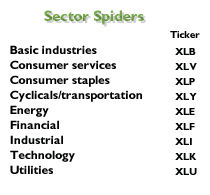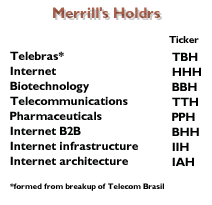|
Index shares explained
|
 |
March 21, 2000: 11:54 a.m. ET
Spiders and Diamonds provide diversification that's easy to understand
By Staff Writer Alex Frew McMillan
|
NEW YORK (CNNfn) - Diamonds. Spiders. Cubes. Webs. Catchy names that mean investors have more jargon to get used to.
But those tools, which fall under the less catchy category of "exchange-traded index shares," can help investors build a diversified portfolio. And you won't have to be a market pro to understand what's in it.
There are now 30 index shares trading on the American Stock Exchange, where they account for over half the volume. Volume this year, 29 million shares a day, is double a year ago.
Volume is much higher on days like last Thursday, when the Dow gained 499 points. A total of 22 million shares of the Nasdaq-100 Index Tracking Stock (QQQ: Research, Estimates), commonly called Qs or Cubes, and 14 million shares of the Standard & Poor's Depositary Receipts (SPY: Research, Estimates), commonly called Spiders, changed hands. All told, 47 million index shares traded, 61 percent of total volume on the exchange.
Well-liked, but not widely understood
Investment advisers generally have good things to say about Cubes, Diamonds and Spiders. But many say investors don't understand them, and some advisers admit they aren't as familiar with them as they should be.
 Nick D'Ambrosio, a certified financial planner with Horizon Planning in New York, does follow them. "I use Spiders and Diamonds for practically all my clients," he said. "They're really competing with mutual funds in a very strong way." Nick D'Ambrosio, a certified financial planner with Horizon Planning in New York, does follow them. "I use Spiders and Diamonds for practically all my clients," he said. "They're really competing with mutual funds in a very strong way."
They work like this. An investment administrator authorizes buying the stocks in an index, forming a "creation unit" held by a trustee. For Diamonds, for instance, State Street Bank and Trust Co. holds the 30 stocks in the Dow Jones industrial average.
The trust company then splits the units into shares that trade at a fraction of the index. For example, Diamonds trade around 1/100th of the value of the Dow. Spiders trade at 1/10th the value of the S&P 500.
On Tuesday, for instance, Diamonds opened at 106-9/16, while the Dow opened at 10,680, almost exactly 100 times the value of the Diamonds. Spiders opened at 145-17/32, while the S&P 500 opened at 1,457, 10 times the value of the Spiders.
On March 16, the day of the Dow's 499-point run-up, Diamonds rose $5.16, slightly ahead of the Dow. Diamonds also paid a dividend the next day, as they do once a month, driven by dividends paid by the underlying Dow companies. Minus the 16 cent a share dividend, Diamonds mimicked the Dow's leap almost exactly, rising $5.
A diverse investment that's easy to track
So an investor can buy a share comprised of the companies in the index and trade it like a stock, with market factors causing the gains and losses to reflect those of the indicators. The investor pays capital gains when the shares are sold. By offsetting redemptions "in kind" against new purchases and changes in the index, the administrator tries to minimize the distributions you get with a typical mutual fund or trust.
 D'Ambrosio likes to use Spiders, Diamonds and Cubes, which track the Nasdaq 100, as core holdings for customers. They provide a broad investing base that his clients find easy to follow. D'Ambrosio likes to use Spiders, Diamonds and Cubes, which track the Nasdaq 100, as core holdings for customers. They provide a broad investing base that his clients find easy to follow.
Because index shares trade like stocks, you can track the price at any time. That's an advantage over mutual funds, which calculate Net Asset Values once a day. Index shares can also be shorted like stocks.
"When clients get to know they own the Nasdaq, they get a little more sense of what's happening," D'Ambrosio said. "It gets the client a little more involved, for those that want to be a little more involved."
An alternative to mutual funds
One disadvantage is that buying index shares always involves a brokerage commission as well as management fees, but there are some no-load mutual funds that will cost nothing extra to buy; there's no transaction fee. There is also a "spread" between bid and asked on products such as Spiders.
But there are other advantages. It's easy to find what's in an index. Standard & Poor's and Dow Jones post the components on their Web sites, for instance. Changes are also announced, typically on a regular basis.
"Because it's an index, you know what you're buying, so you don't worry about the manager," D'Ambrosio said. Mutual funds only declare their holdings twice a year. And some managers engage in "window dressing," buying big movers before they reveal their holdings.
Index shares are also passively managed -- holdings follow the index. So they charge lower fees than many funds. For instance, the "big Spider" recently lowered its management fee to 0.12 percent a year, undercutting the Vanguard 500 Index Fund (VFINX), which charges 0.18 percent.
After a slow start, index shares are catching on
There are nine industry-specific Spiders, which D'Ambrosio uses occasionally. He buys around their 52-week lows. The financial-sector Spider hit that on March 8. "Financials are not going to die, so we used that as an easy entrée," he said.
AMEX and S&P rolled out the original Spider as a unit investment trust at the start of 1993, but it and its cousins took a couple of years to catch on.
"It was quite slow," concedes Larry Larkin, senior vice president of index-share products for AMEX. "In 1993, about eight of us thought that the portfolio trading on an exchange would make sense."
AMEX needed something to bolster trading volumes. Investors warmed to Spiders as the S&P 500 outperformed other indexes and also beat out many active mutual funds.
Specialized products the last two years
So AMEX encouraged similar products. In May 1995, it started trading mid-cap Spiders (MDY: Research, Estimates), tracking the S&P MidCap 400.
Index shares have gotten more specialized ever since. In January 1998, Diamonds (DIA: Research, Estimates) debuted after Dow Jones started licensing the Dow name.
 In December 1998, sector Spiders came out. The nine sector Spiders, such as Technology (XLK: Research, Estimates), Energy (XLE: Research, Estimates), Financials (XLF: Research, Estimates), and Utilities (XLU: Research, Estimates), break the S&P 500 into industries. In December 1998, sector Spiders came out. The nine sector Spiders, such as Technology (XLK: Research, Estimates), Energy (XLE: Research, Estimates), Financials (XLF: Research, Estimates), and Utilities (XLU: Research, Estimates), break the S&P 500 into industries.
The Cubes (QQQ: Research, Estimates), which have proved popular given Nasdaq's 85.6 percent increase last year, came out in March 1999.
There are also 17 Webs, World Equity Benchmark Shares, managed by index-fund specialist Barclays Global Investors and based on indexes from Morgan Stanley Capital International.
Webs track international markets, including Australia (EWA: Research, Estimates), Germany (EWG: Research, Estimates), Japan (EWJ: Research, Estimates), Mexico (EWW: Research, Estimates) and the United Kingdom (EWU: Research, Estimates).
 There are subtle differences among index shares. Webs and the sector Spiders are, technically, mutual funds -- although their value changes throughout the day, as opposed to the once-a-day revaluation of traditional funds. There are subtle differences among index shares. Webs and the sector Spiders are, technically, mutual funds -- although their value changes throughout the day, as opposed to the once-a-day revaluation of traditional funds.
But the big Spider, Diamonds and Cubes are unit investment trusts. Mutual funds can reinvest dividends immediately, which unit investment trusts only pay at intervals, normally quarterly.
A mutual fund also has a board of directors. Unit investment trusts don't, which means there's less supervision. But management fees for UITs are a little lower. UITs normally have a set lifespan, but Larkin says Spiders "for all purposes are never going to expire," because State Street keeps extending it.
Though investors should read the small print, D'Ambrosio doesn't think the structural differences are significant. UITs have some "dividend lag" over mutual funds. But unless you're an institution, the effect is negligible. "Nobody really cares if they're making $300 less over a lifetime," he said.
More index-share products on the way
Barclays plans to introduce up to 50 new exchange-traded products this year. It has filed for 11 new Webs, mainly for emerging markets such as South Africa, Greece and Thailand. It is developing shares following the S&P Global 100 index of large multinationals, to trade on the New York Stock Exchange.
Merrill Lynch has developed Holdrs, depositary receipts that also track specific sectors. There are now eight, including Biotechnology (BBH: Research, Estimates), the Internet (HHH: Research, Estimates) and Pharmaceuticals (PPH: Research, Estimates). Merrill plans to roll out between eight and 12 more this year.
Holdrs also have a slightly different structure, never changing holdings unless companies dissolve or are bought out. Investors can trade Holdrs, which last for 40 years, for the underlying stock at any time.
Holdrs, Webs and sector Spiders allow for targeted investing. But the more specific the product, the less the diversification and the higher the risk. "For small investors, they probably aren't the place to be," said Scott Kahan, a financial planner and president of Financial Asset Management in New York.
-- Click here to send email to Alex Frew McMillan
Got questions about financial planning? Need some advice? CNNfn.com has organized a panel of outside experts to answer your questions. If you want to be considered for our "Checks and Balances" column, where professional planners suggest ways you can manage your money, send us an e-mail at consumer@cnnfn.com. Include information about your age, occupation, income and assets. Also, share with us any short-term and long-term financial goals you may have. And don't forget to leave your phone number. 
|
|
|
|
|
 |

|

